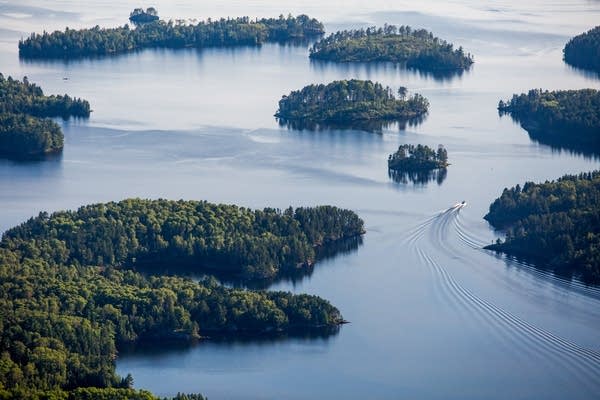Voyageurs, Minnesota’s only national park, celebrates 50th anniversary

Go Deeper.
Create an account or log in to save stories.
Like this?
Thanks for liking this story! We have added it to a list of your favorite stories.
Voyageurs National Park — Minnesota’s only park in the national park system— celebrates its 50th anniversary Tuesday.
The park protects a watery wilderness of nearly 220,000 acres of boreal forest, vast lakes dotted by hundreds of islands, and dramatic, rocky shorelines spanning a 55-mile section of the Canadian border between International Falls and Crane Lake.
“It’s a really, really special landscape,” said Barb West, the park’s superintendent from 1995 to 2005. “Big skies, big trees, big rocks, big water. There’s no place in the National Park Service that’s quite like it.”
That’s partly because many of the park’s attractions are accessible only by boat, such as a private motorboat, canoe or kayak, a tour boat operated by the National Park Service or a house boat rented from a local outfitter.
Turn Up Your Support
MPR News helps you turn down the noise and build shared understanding. Turn up your support for this public resource and keep trusted journalism accessible to all.
That makes the park more challenging to visit. It averages around 250,000 visitors a year, a figure that’s held fairly steady for years, aside from an uptick during the COVID-19 pandemic. Many Minnesota state parks see more than twice that number of visitors.
But as a result, there’s also a remoteness at Voyageurs that’s rare among national parks. Many campsites are situated so that no other campers are visible.
“You can be in so many remote areas … and not even know you’re maybe in a national park, because you’re not driving along a road and pulling over by a sign,” said Christina Hausman Rhode, executive director of Voyageurs Conservancy, a nonprofit advocate and fundraiser for the park.
“It’s really that unique, wild character and solitude that you can't always get at other national parks.”
A contentious history
The area encompassing Voyageurs National Park and its chain of four enormous lakes — Rainy, Kabetogama, Namakan and Sand Point— was inhabited by Indigenous people for thousands of years.
Most recently, Ojibwe people called it home. Members of the Bois Forte Band of Chippewa lived there into the early 1900s, decades after the U.S. government, eager for access to timber and minerals, took the land from the tribe in treaties signed in the mid-1800s.
The park takes its name from the French voyageurs, who traveled through the area, part of a major fur trade route, over 250 years ago.
The creation of the national park was the culmination of nearly a century of advocacy. The state legislature first called for establishing a national park along the border lakes in 1891.
In the early 1900s, Sigurd Olson, Ernest Oberholtzer and other conservationists pushed for protecting the entire border region from Voyageurs to the Boundary Waters.

But by the time the park was authorized and signed into law by President Richard Nixon in 1971, much of the land within park boundaries was privately held by paper companies and families that built cabins on islands and along the lakeshore.
“The park was established through the sale of a lot of private property,” said current park superintendent Bob DeGross. “You know, long-held family properties by individuals that were within what is now the boundary of the park. So people sacrificed their land for the greater good of having a national park in the state.”
But some in the area resented the government's takeover of the land. And that sentiment persisted for decades.
When Barb West began her term as superintendent in 1995, 20 years after the park’s establishment, she found herself contending with lawsuits, congressional hearings, even a proposal to turn over management of the park to a local group.
“For some people, they thought everything was just fine the way it was, and didn’t want change,” said West. “There was also sort of a streak of ‘anti-government-ness.’ We don’t need somebody to tell us what to do kind of attitude.”
When the park was created, the park made offers to buy land from individual cabin owners. Some took the offers, but others stayed in their cabins on 25-year leases. During West’s tenure, those families had to permanently leave their cabins.
Other families chose lifelong leases. There are still about 40 private parcels remaining in the park.
West said beyond the private property owners, other area residents had long become accustomed to hunting and using land that had been owned by paper companies without any restrictions.
“It was just part of sort of their birthright. And as things changed, and this also applies to the Boundary Waters, as the federal government made rules that said you could do this, but you can't do that, people were pretty resentful,” said West. “It was a hard time.”
Park officials say over time, those attitudes have softened.
“More often than not, what I hear is, ‘You know, my dad or my grandfather was very much against the park,’ but now, people come and say, ‘We see the benefit of the park being here,’” said park superintendent Bob DeGross.

A new visitor center opens this June in Crane Lake, one of the park’s gateway communities. Many local businesses cater to the park's quarter million annual visitors. And park advocates say people increasingly recognize the intrinsic value of thousands of miles of undeveloped shoreline at a time when many of the state's lakes are now ringed with cabins.
“I think Voyageurs marks one of those special landscapes in our state where we’ve set aside something as a national treasure, as a Minnesota treasure, and said, you know, we're not going to develop this,” said Hausman Rhode. “We’re going to preserve the lands, waters and skies of this place. And that’s super important.”
She and others acknowledge challenges ahead for Voyageurs and other parks grappling with staffing cuts and federal budget uncertainty. At least one park employee was terminated in recent federal cuts, DeGross said he couldn’t comment on personnel matters.
“If we can use the 50th anniversary as an opportunity to thank our park staff and to have a little bit of a spotlight on why this place is special and why it’s worthy of funding and stability, I think that's an important moment for us to take,” Hausman Rhode said.
Anniversary celebration
The National Park Service and Voyageurs Conservancy are planning anniversary events throughout the coming year.
Gov. Tim Walz will proclaim April 8 “Voyageurs National Park Day” in Minnesota.
A behind-the scenes archives tour and open house will be held at the park’s headquarters in International Falls from 3 p.m. to 6 p.m. A virtual webinar begins at noon.
For other events, visit voyageurs.org/50th.



